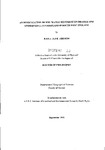AN INVESTIGATION OF SOIL WATER MOVEMENT ON DRAINED AND UNDRAINED CLAY GRASSLAND IN SOUTH WEST ENGLAND
| dc.contributor.author | ADDISON, PAULA JANE | |
| dc.contributor.other | School of Geography, Earth and Environmental Sciences | en_US |
| dc.date.accessioned | 2013-10-07T11:13:50Z | |
| dc.date.available | 2013-10-07T11:13:50Z | |
| dc.date.issued | 1995 | |
| dc.identifier | NOT AVAILABLE | en_US |
| dc.identifier.uri | http://hdl.handle.net/10026.1/2062 | |
| dc.description.abstract |
The Rowden Moor experimental site (A.F.R.C. I.G.E.R., North Wyke) provided an opportunity to characterise discharge regimes, elucidate runoff generation mechanisms and to consider implications for solute movement under natural and drained conditions. Research was conducted on a heavy clay grassland soil in an area of high rainfall (1053 mm a ˉ¹) in South West England. A combined hydrometric and tensiometric study was undertaken within a nested experimental design (1 m² to 1 ha) on one undrained and one drained site throughout a drainage season (October to March). Results at the hectare scale demonstrated that drainage did not substantially alter the volume of field runoff ( ~ 400 mm) but did change the dominant flowpaths. Drainage diverted water from surface/near surface routes to depth so that drain storm runoff was lagged by some 30 minutes over undrained site discharge. The drained site also exhibited a more peaky regime, with a maximum daily discharge of 45 mm being almost twice that for the undrained field. At the field and plot scale, the significance of macropore flow was noted. To investigate this in more detail, a tracer experiment was performed on an isolated soil block which had been mole drained and so had enhanced macroporosity. Macropore flow was generated under unsaturated conditions (little matric potential response and no water table was identified). Stable oxygen concentrations were δ18O +3.5 and -5.8 in tracer and background water respectively. Drainflow indicated that there was rapid interaction between applied tracer and soil water (peak flow δ18O -1.1). Thus, the matrix-macropore interface was not a boundary between two separate domains of old and new water, high and low conductivity but a site of rapid interchange and mixing. Temporal variability of soil status and malric water composition, also indicated that limited areas of the matrix were capable of transmitting rapid flow. It became clear that even in a heavy clay soil such as that found at Rowden, where macropore flow was promoted by drainage operations, the matrix still had an important role to play. On the basis of potential, soil moisture and observation of tracers, it is proposed that discrete (finger-like) volumes of the matrix are capable of rapid water transmission. Although it was frequently impossible to relate moisture content and soil water potential because instrumentation monitored different volumes of soil, hysteretic soil moisture behaviour over the drainage season was evident in both data sets. This study confirmed the importance of rapid subsurface runoff generation mechanisms on drained soils, but noted that discontinuous translatory flow in the matrix and macropore flow occurred and that the two ‘domains’ were inextricably linked. Further work should be undertaken at the detailed scale to elucidate the soil characteristics which promote rapid runoff mechanisms and the consequences for water quality, especially where the soil subsurface represents a major reservoir (e.g. nitrates). | en_US |
| dc.description.sponsorship | A.F.R.C. Institute of Grassland and Environmental Research, North Wyke | en_US |
| dc.language.iso | en | en_US |
| dc.publisher | University of Plymouth | en_US |
| dc.title | AN INVESTIGATION OF SOIL WATER MOVEMENT ON DRAINED AND UNDRAINED CLAY GRASSLAND IN SOUTH WEST ENGLAND | en_US |
| dc.type | Thesis | |
| plymouth.version | Full version | en_US |
| dc.identifier.doi | http://dx.doi.org/10.24382/1543 | |
| dc.identifier.doi | http://dx.doi.org/10.24382/1543 |
Files in this item
This item appears in the following Collection(s)
-
01 Research Theses Main Collection
Research Theses Main


